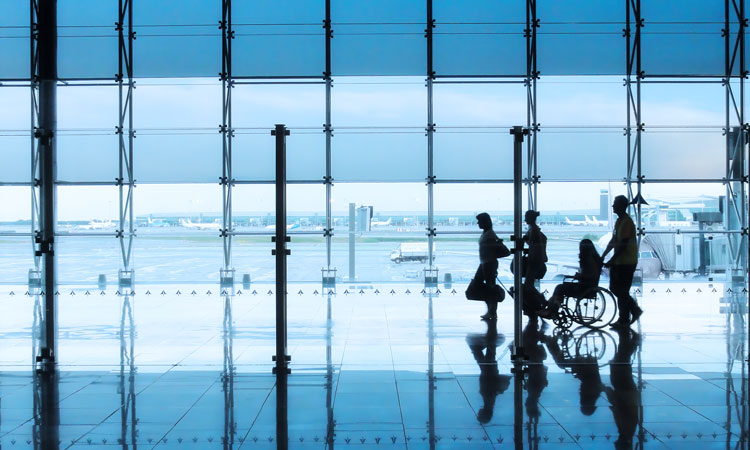The importance of coordination and advancing accessible air travel during the pandemic
- Like
- Digg
- Del
- Tumblr
- VKontakte
- Buffer
- Love This
- Odnoklassniki
- Meneame
- Blogger
- Amazon
- Yahoo Mail
- Gmail
- AOL
- Newsvine
- HackerNews
- Evernote
- MySpace
- Mail.ru
- Viadeo
- Line
- Comments
- Yummly
- SMS
- Viber
- Telegram
- Subscribe
- Skype
- Facebook Messenger
- Kakao
- LiveJournal
- Yammer
- Edgar
- Fintel
- Mix
- Instapaper
- Copy Link
Posted: 28 May 2021 | Linda Ristagno | 2 comments
Linda Ristagno, Assistant Director of External Affairs at the International Air Transport Association (IATA), updates International Airport Review on the work that IATA has been doing to further the accessible air travel agenda.


According to the United Nations World Tourism Organization (UNWTO), approximately one in five people have a disability globally – some permanent, some temporary, some visible and some invisible – and, as the population ages, that proportion is set to increase.
Since the adoption of the landmark UN Convention on the Rights of Persons with Disabilities (UNPDR) in 2006, there has been a positive increase in the level of awareness and policy actions surrounding disability in air transport; many regulators, for instance, have implemented, or are implementing, domestic rules regarding accessible air travel. This has resulted in some positive movement, but has also slowly created a landscape of differing national regulations across the globe. This regulatory patchwork creates challenges for travellers, airports and airlines alike. By its very nature, international air transport operates across multiple national jurisdictions and relies on global standards. For passengers with disabilities, different accessibility regimes in different jurisdictions can result in differing expectations and frustration. For airlines and airports, this fragmentation increases compliance complexity and costs.
In June 2019 at the IATA annual general meeting, IATA member airlines voted unanimously in favour of an industry resolution to improve the air travel experience for travellers with disabilities. It was a watershed moment for the accessibility journey of the airline industry. Through the AGM Resolution, airlines reconfirmed their commitment to improve accessibility in air transport and urged states to work in partnership with the air transport industry when developing policies and procedures related to accessible air transport.
For passengers with disabilities, different accessibility regimes in different jurisdictions can result in differing expectations and frustration”
More importantly, with the resolution, the airline industry commits to put individuals with disabilities at the forefront of their activities and to balance the accessibility needs of passengers with operational realities.
During 2019, a number of initiatives were launched to address some priority areas for the industry. For example, to address the issue of wheelchair assistance at airports, workshops were held at London Heathrow Airport (LHR), Indira Gandhi International Airport (DEL) and John F. Kennedy International Airport (JFK), with representatives from regulators, airlines, disability organisations, airports and other regional stakeholders, to assess current realities, challenges and opportunities.
In addition, IATA established a new forum through which disability associations, policy makers and industry could exchange views about how best to facilitate a regulatory framework that both reduces operational complexity and increases accessibility. For instance, by gathering invaluable input directly from the disability community, IATA was able to produce guidance material to address the issue of the safe loading of battery powered wheelchairs.
From the regulatory perspective, the General Assembly of the International Civil Aviation Organization (ICAO) recognised that a harmonised approach to the work on accessibility in aviation is a contributor to the achievement of the UN Sustainable Development Goals (SDGs) and agreed that, where appropriate, Member States should consider the IATA core principles on passengers with disabilities when developing and implementing accessibility regulations.
Another major milestone was the launch of the first IATA Global Accessibility Symposium, the first event of its kind, seeking to improve the air travel experience for passengers with disabilities. The symposium created a unique platform that brought together about 200 players from across the air travel ecosystem to share expertise and experience, as well as set priorities for the industry. The attendees included delegates from accessibility associations, advocacy groups, airlines, airports, regulators, ground handlers, suppliers and more.
COVID-19 and accessible air travel
Since March 2020, the airline industry has experienced its greatest crisis since the first international commercial flight a century ago. The collapse of air travel because of the COVID-19 pandemic effectively emptied the skies. However, as the industry emerges from the crisis, airlines want to build back a more accessible and inclusive air travel experience.
Despite the devastating effects of the pandemic on air transport, people across the industry were determined to continue to work on accessibility initiatives, from developing industry guidance and continuing to build dialogue with the disability community, to exploring new technological innovations to make travel easier.
Here are five key ways that IATA and the industry worked with the disability community to make progress since 2020:
Working with stakeholders on guidance
Airlines teamed up with IATA’s existing Accessibility Working Group and with two accessibility associations – the Open Doors Organization and Reduced Mobility Rights Limited – to develop guidance for the airline industry for the restart of air travel. The result was the ‘IATA Guidance on Accessible Air Travel in Response to COVID-19’, which outlines accessibility considerations for COVID-19 measures and policies, both during the pandemic and beyond. The guidance advocates for a coordinated, predictable and non-discriminatory approach to biosafety measures. Overall, the aim of the guidance is to help to support and inform policy as airlines welcome passengers with disabilities back to the skies.
Guiding policy considerations on masks for travellers with disabilities
Airlines also worked with state regulators and disability associations to develop new policy and standards on the use of face coverings, masks and personal protective equipment. This included considerations for airlines regarding passengers who cannot put on or remove a face mask themselves, small children and those with medical conditions who may not be able to tolerate the use of masks for lengthy periods. New standard codes have been developed to allow airlines to capture information regarding additional documentation checks and mask exemptions and communicate with third party ground handlers, cabin crew, partner carriers or internal airport teams. Policy and guidance will reduce the inconsistent application of mask policies by better identifying those passengers who have difficulties in wearing a mask while travelling.
Bringing industry and the community together
As mentioned above, the IATA Global Accessibility Symposium is the only event of its kind with a focus on air travel and accessibility. It brought together accessibility advocacy groups, travellers, airlines, policymakers and other stakeholders. The second edition took place in a virtual format in October 2020 and brought together some 400 people from around the globe. The aim was to continue building better understanding between the accessibility and aviation communities by sharing real experiences, perspectives and expertise. Panel discussions looked at how airlines can provide the best service to travellers with disabilities, including topics like wheelchair assistance and the loading of mobility aids. The symposium also featured sessions with stakeholders in travel and tourism and dialogue with forward-thinking regulators on their upcoming regulations. This highlighted the importance for industry and regulators to work together to make certain that future policy and regulation related to accessibility is consistent for everyone, ensuring that no one is left behind.
Engaging innovative thinkers
An AIR Hackathon on Reduced Mobility took place at the Microsoft headquarters in Seattle in February 2020, prior to the COVID-19 outbreak. The hackathon registered a record participation of 180 attendees, with teams composed of 120 developers who were supported by mentors, airlines, travel agents, airports, aircraft manufacturers and members of the disability community. The innovators looked at how to tackle issues around the digital booking, tracking, safe storage and transportation of wheelchairs – with the overall aim to give peace of mind to passengers and airlines, and lead to fewer cases of damaged or misplaced wheelchairs. This was the first hackathon held by IATA focusing on leveraging technology to improve the journey for travellers with disabilities.
Sharing global best practices
The first edition of the IATA Passenger Accessibility Operations Manual (IPAOM) was released in February 2021. The guidance manual is the result of an intensive one-year consultation with the industry and input from disability organisations. It intends to provide reference to support airline members in assisting travellers with disabilities, with the aim of delivering a smooth and dignified travel experience throughout the passenger journey. The manual is primarily designed to promote a much broader understanding of established industry processes in alignment with major existing rules and regulations.
The future
IATA and the industry are working very closely with major governments to support a safe restart for passengers with disabilities. Upcoming focus areas will include continuing to develop meaningful dialogue between the accessibility and aviation communities, better education of the travel chain, and reviewing and modernising standards and processes.
The damage of assistive devices has been identified as an important topic that needs to be addressed, and this will be a key area in the work going forward. Working with governments, airports and other partners on consistency in regulation will also be a crucial foundational element to these efforts. After all, along with travellers with disabilities, airlines are on the same page in wanting to make the freedom to fly for all. This crisis presents an opportunity for our sector and many others to build forward better and create a society that is more accessible and inclusive.


Linda Ristagno
Linda is the global policy advocate for IATA on accessibility for passengers with disabilities and the aging population. In her role, she is the secretary of the Accessibility Working Group, which drives the execution of IATA’s accessibility strategy and ensures that policy and activities are representative of the needs of member airlines and passengers through regular consultation with disability associations, regulators, airports and international organisations. Linda holds an Executive Master Diploma in International Negotiation and Policymaking with the Graduate Institute of International and Development Studies of Geneva.



















Excellent report
Thank you Fazal, glad you enjoyed it!